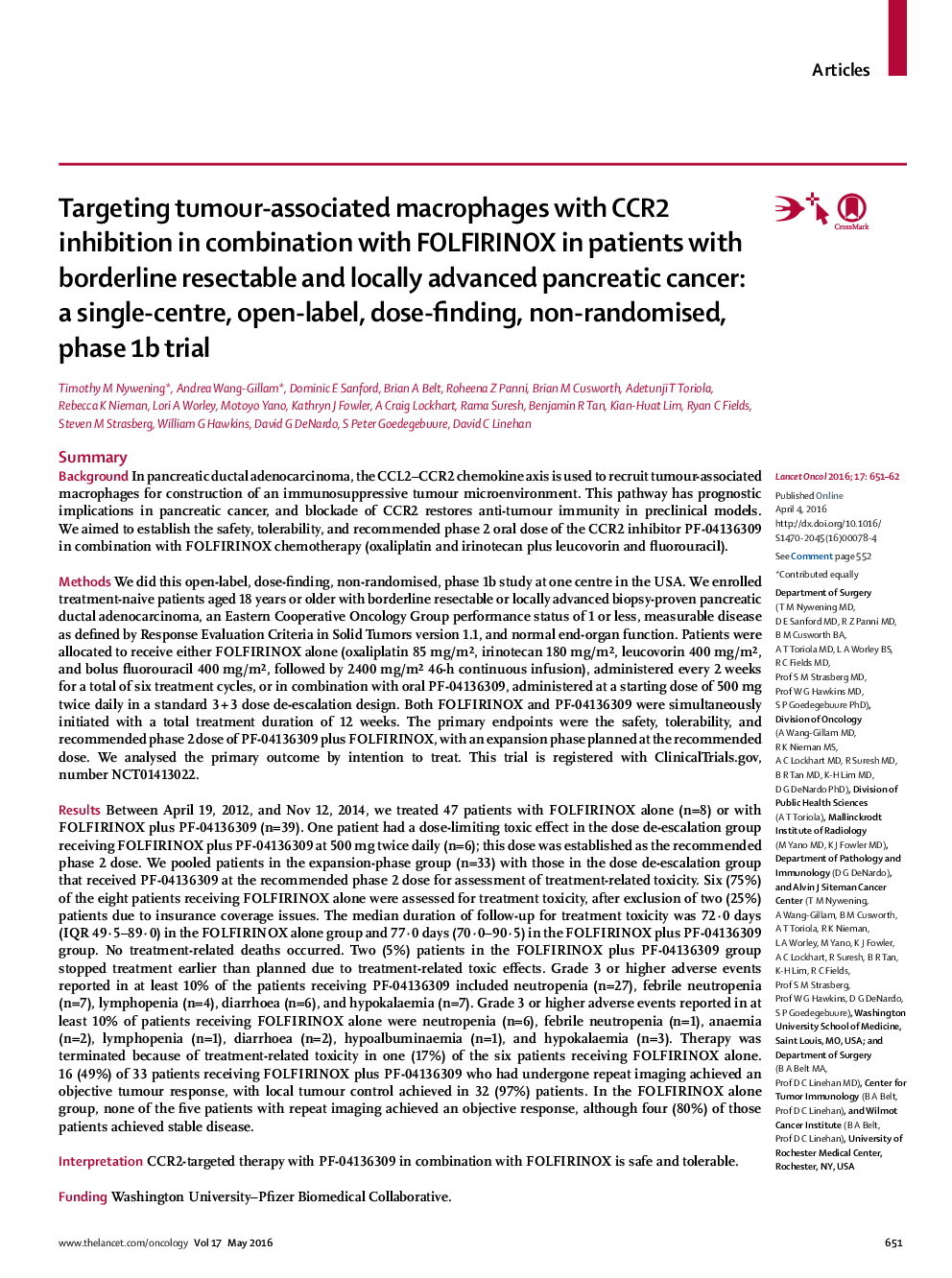| Article ID | Journal | Published Year | Pages | File Type |
|---|---|---|---|---|
| 3993224 | The Lancet Oncology | 2016 | 12 Pages |
SummaryBackgroundIn pancreatic ductal adenocarcinoma, the CCL2–CCR2 chemokine axis is used to recruit tumour-associated macrophages for construction of an immunosuppressive tumour microenvironment. This pathway has prognostic implications in pancreatic cancer, and blockade of CCR2 restores anti-tumour immunity in preclinical models. We aimed to establish the safety, tolerability, and recommended phase 2 oral dose of the CCR2 inhibitor PF-04136309 in combination with FOLFIRINOX chemotherapy (oxaliplatin and irinotecan plus leucovorin and fluorouracil).MethodsWe did this open-label, dose-finding, non-randomised, phase 1b study at one centre in the USA. We enrolled treatment-naive patients aged 18 years or older with borderline resectable or locally advanced biopsy-proven pancreatic ductal adenocarcinoma, an Eastern Cooperative Oncology Group performance status of 1 or less, measurable disease as defined by Response Evaluation Criteria in Solid Tumors version 1.1, and normal end-organ function. Patients were allocated to receive either FOLFIRINOX alone (oxaliplatin 85 mg/m2, irinotecan 180 mg/m2, leucovorin 400 mg/m2, and bolus fluorouracil 400 mg/m2, followed by 2400 mg/m2 46-h continuous infusion), administered every 2 weeks for a total of six treatment cycles, or in combination with oral PF-04136309, administered at a starting dose of 500 mg twice daily in a standard 3 + 3 dose de-escalation design. Both FOLFIRINOX and PF-04136309 were simultaneously initiated with a total treatment duration of 12 weeks. The primary endpoints were the safety, tolerability, and recommended phase 2 dose of PF-04136309 plus FOLFIRINOX, with an expansion phase planned at the recommended dose. We analysed the primary outcome by intention to treat. This trial is registered with ClinicalTrials.gov, number NCT01413022.ResultsBetween April 19, 2012, and Nov 12, 2014, we treated 47 patients with FOLFIRINOX alone (n=8) or with FOLFIRINOX plus PF-04136309 (n=39). One patient had a dose-limiting toxic effect in the dose de-escalation group receiving FOLFIRINOX plus PF-04136309 at 500 mg twice daily (n=6); this dose was established as the recommended phase 2 dose. We pooled patients in the expansion-phase group (n=33) with those in the dose de-escalation group that received PF-04136309 at the recommended phase 2 dose for assessment of treatment-related toxicity. Six (75%) of the eight patients receiving FOLFIRINOX alone were assessed for treatment toxicity, after exclusion of two (25%) patients due to insurance coverage issues. The median duration of follow-up for treatment toxicity was 72·0 days (IQR 49·5–89·0) in the FOLFIRINOX alone group and 77·0 days (70·0–90·5) in the FOLFIRINOX plus PF-04136309 group. No treatment-related deaths occurred. Two (5%) patients in the FOLFIRINOX plus PF-04136309 group stopped treatment earlier than planned due to treatment-related toxic effects. Grade 3 or higher adverse events reported in at least 10% of the patients receiving PF-04136309 included neutropenia (n=27), febrile neutropenia (n=7), lymphopenia (n=4), diarrhoea (n=6), and hypokalaemia (n=7). Grade 3 or higher adverse events reported in at least 10% of patients receiving FOLFIRINOX alone were neutropenia (n=6), febrile neutropenia (n=1), anaemia (n=2), lymphopenia (n=1), diarrhoea (n=2), hypoalbuminaemia (n=1), and hypokalaemia (n=3). Therapy was terminated because of treatment-related toxicity in one (17%) of the six patients receiving FOLFIRINOX alone. 16 (49%) of 33 patients receiving FOLFIRINOX plus PF-04136309 who had undergone repeat imaging achieved an objective tumour response, with local tumour control achieved in 32 (97%) patients. In the FOLFIRINOX alone group, none of the five patients with repeat imaging achieved an objective response, although four (80%) of those patients achieved stable disease.InterpretationCCR2-targeted therapy with PF-04136309 in combination with FOLFIRINOX is safe and tolerable.FundingWashington University–Pfizer Biomedical Collaborative.
